“When the pups pop, get them out while they’re little.”
That’s good advice from Mr. Smarty Plants, a collective of volunteers who’ve answered thousands of questions posed to the Ladybird Johnson Wildflower Center over the years. The guidance would have come in handy before I planted several Agave americana more than a decade ago around our ranch house along the Llano River. Their blue-green fleshy leaves, exotic profile and reputation for low maintenance in brutal Texas summers seemed a perfect match for the rocky caliche soil and lack of water at the ranch.
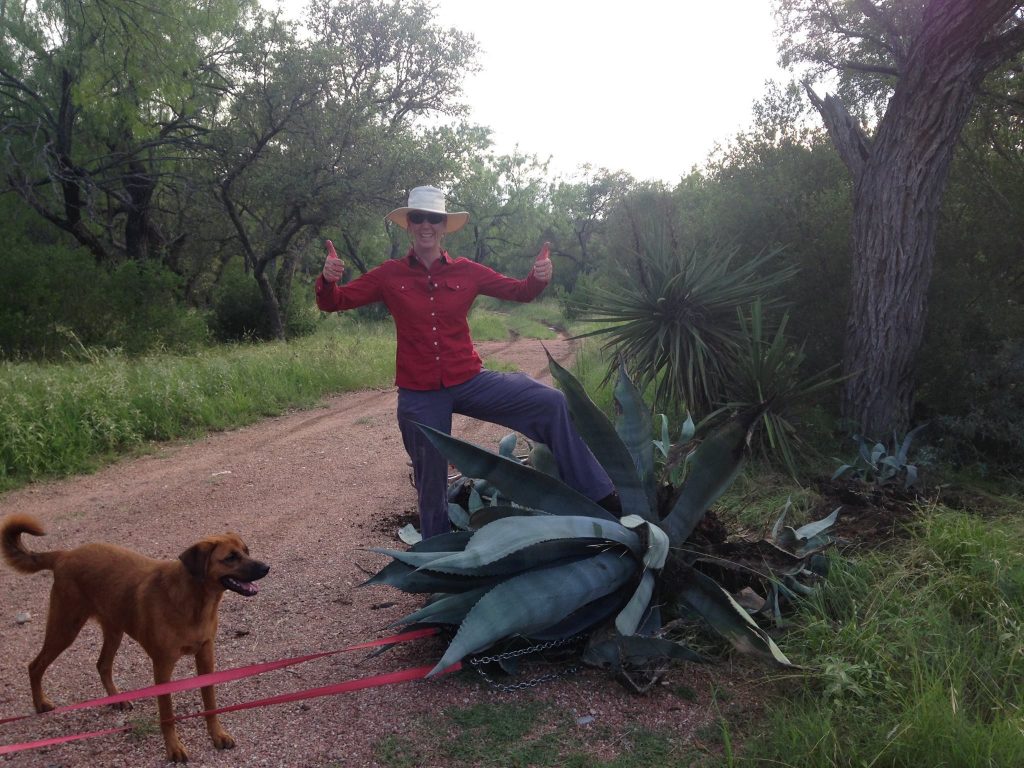
Dr. Kelly Lyons, a grass expert and biology professor at Trinity University, stands victorious over an Agave americana. Brisket Rivard (left) assists. Photo by Monika Maeckle
But since we only visit the property every other weekend, some times less, my agaves became a nuisance. Too often I was absent. I failed at plant management. As Mr. Smarty Plants advises, thinning the pups early, while they’re manageable and have shallow roots, is imperative to avoiding an ornery agave cluster. I ignored the agaves entirely for more than a decade. The result? Several mean agave forests that pricked and poked anyone who dared approach.
Let there be no mistake: Agave Americana deserves our respect. The plant is a case study in self-reliance, asking for NOTHING in exchange for its reliable growth and eventual stunning presence. It demands no supplemental water, no fertilizer, no pruning, no prissing. It lives a dramatic semelparous life–that is, it enjoys a singular episode of reproduction. Then it dies.
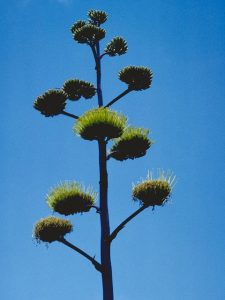
Agave americana blooms only once in its lifetime. Photo via Ladybird Johnson Wildflower Center
With a lifespan between 10 and 30 years, the agave shoots one dramatic stalk yards into the sky. The resulting candelabra-like branchlets sport clusters of yellow flowers. Hummingbirds and bats love this pollen trove. Agave americana, technically native to Mexico, also is found in South Texas. Climate change inevitably will extend its range north.
Dr. Kelly Lyons, a grass expert at Trinity University, suggests the plant be put on the “watch list” as potentially invasive. It’s already been labeled unwelcome and invasive in sand dunes, where it overwhelms all competitors. Left to its own devices, the plant dominates, its rhizomes and pups forming dense communities around the mother plant. Each one has its own set of needle-tipped leaves and serrated blade-like fronds.
I stupidly imported Agave americana to our ranch a dozen years ago. I planted one each on either side of our front gate, thinking they would “welcome” visitors with their dramatic poise. Others I plugged in around the house, some along a much-used trail and a couple along our switchbacked main dirt road.
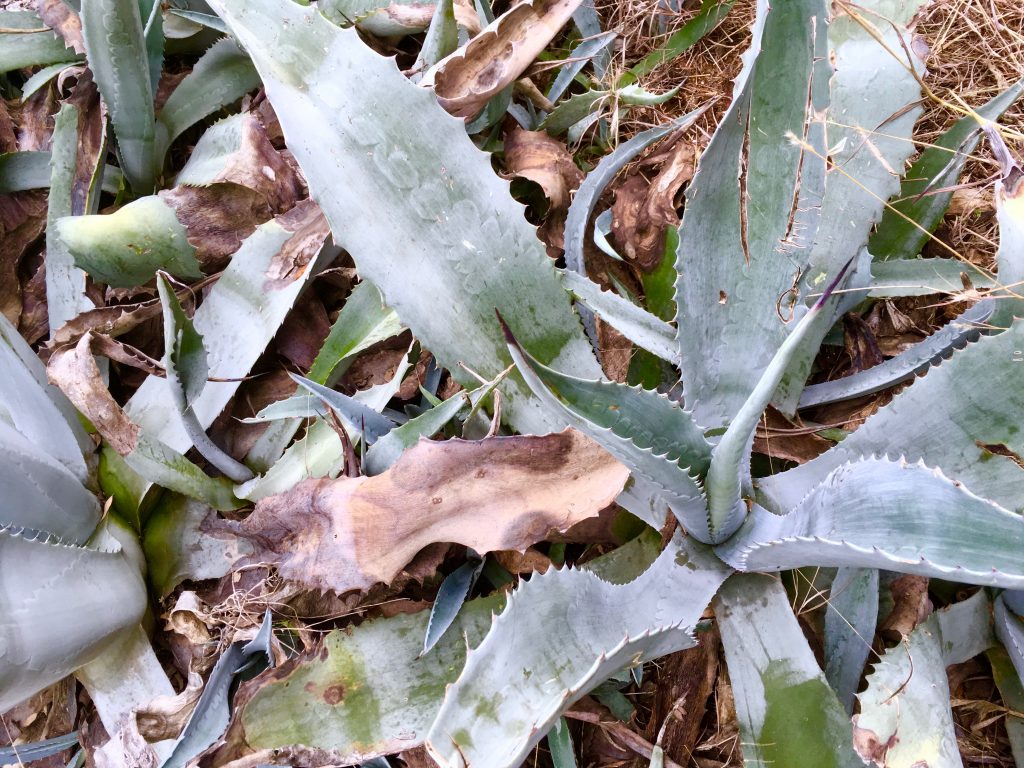
Good luck getting your shovel through this. Photo by Monika Maeckle
Quiet and understated in their youth, the mature agaves seemed daunting. Their passel of pups defended each mother plant like a thorny army. Nothing could be less welcoming at our front gate than getting stabbed by these mean-spirited cacti. Needle-nosed agave fronds prickled and poked whoever was assigned to lock or unlock the gate; their barbed leaves snagged on your shirt and skin, often leaving a sticker behind.
I had been stabbed one too many times. I decided to tackle the out-of-control succulents, which by this time, stood taller than my five-foot-six-inch frame. Leather
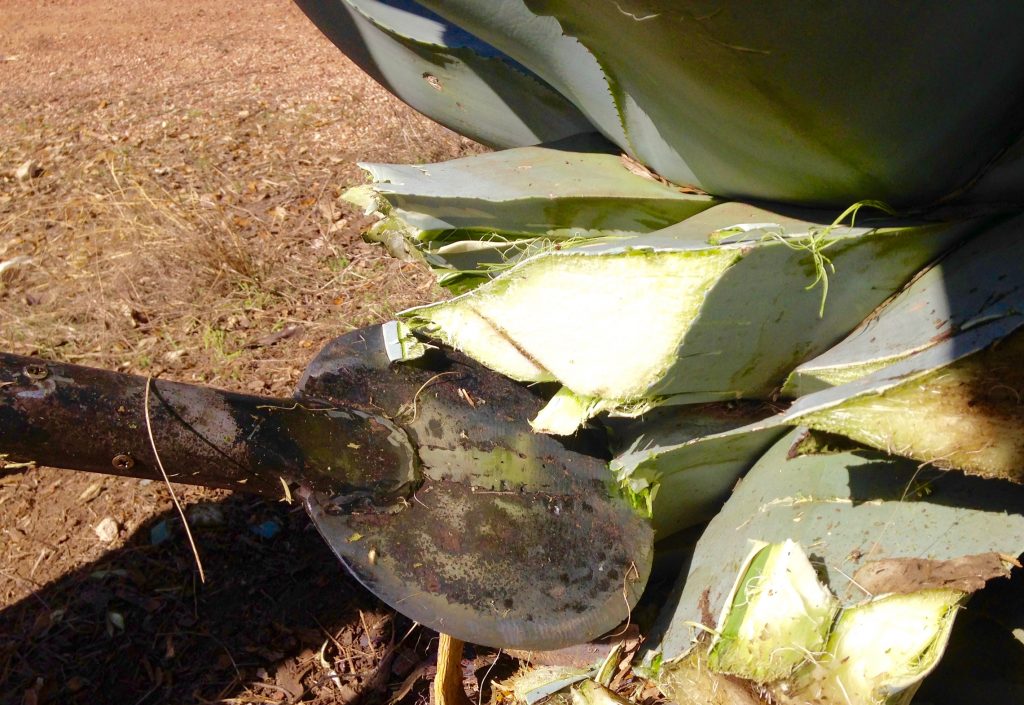
Some of the agave leaves are almost a half-foot thick at their base. Photo by Monika Maeckle
gloves, long sleeves, thick jeans, a sturdy hat and glasses became my agave fighting uniform.
I started with a shovel on one four-foot specimen behind the house. Approaching the plant was practically impossible. The gnarly agave colony fended me off, aggressively protecting its mama with their intertwined roots and serrated leaves. As Mr. Smarty Plants says, agaves self propagate via rhizomes, sending shallow-rooted baby plants all around the base rosette. This helps absorb water in the dry climate in which it thrives. The roots become intertwined, knitted together like an impenetrable quilt. As dead agave blades die and dry out atop them, a sinewy mulch results. A shovel cannot penetrate the fibrous mass.
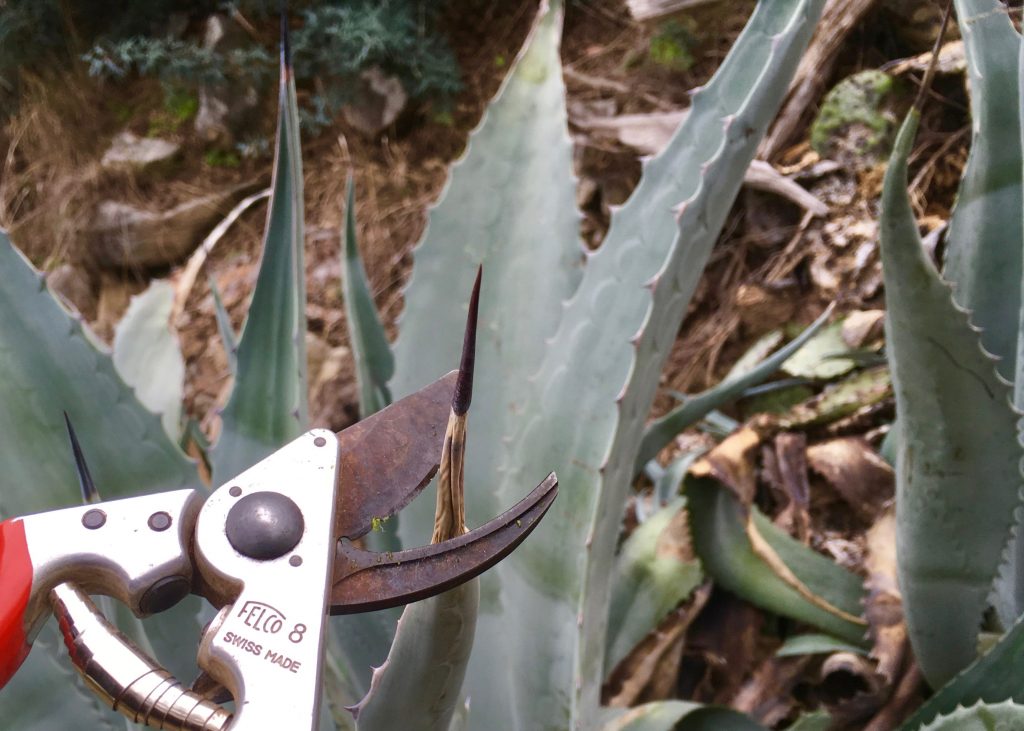
If you take on an agave, be sure to cut off the black needle-like tip from the Agave leaves before you start working. Photo by Monika Maeckle
Intrigued by this seeming fortress surrounding the agaves, I researched and learned that the thick agave leaves, plump with water, also contain stringy sisal fiber that native peoples and later Westerners used to weave baskets, rugs, ropes and blankets. Cutting these sinewy leaves to gain access to the soil to dig up the root becomes a separate challenge requiring sharp shears, a knife, nippers or a coba, a special tool from Mexico that a cactus grower friend supplied to us. Some of the fleshy leaves approach a half-foot girth at their base.
Frustrated, one day I convinced my older son Nicolas to get out the chainsaw. Even though we both wore long sleeves, hats and sun glasses, the agave juice spattered on exposed skin and caused painful welts and blisters that lingered for weeks. Nicolas had an allergic reaction that also caused a rash.
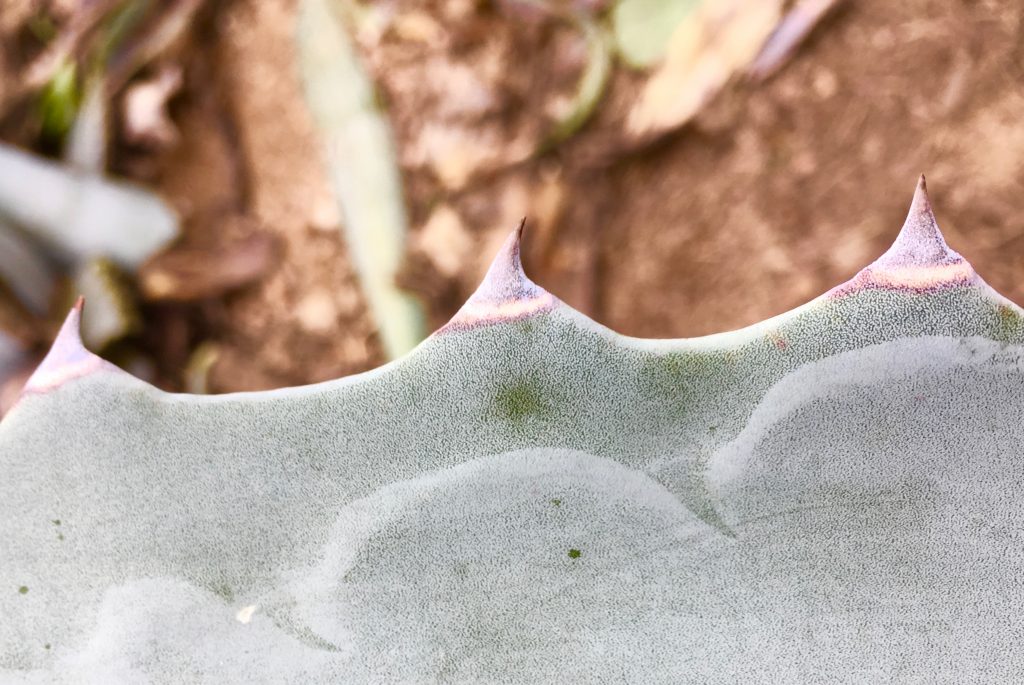
The leaves of Agave Americana are barbed and ornery. #watchout Photo by Monika Maeckle
Then I tried setting the agave on fire using kindling and later charcoal fire starter. Keeping the fire alive was a challenge given the agave’s high moisture content–like burning a watermelon. Eventually, the flame caught. The plant literally shed tears as water drooled down the sides of its sword like leaves. A sad sight, but I still had to dig the root rosette up with a shovel.
I even considered herbicides, but the mass of the plants would require such enormous doses, that just seemed wrong.
Finally, an experienced landscaper suggested I wrap a chain or towing strap around the plant’s base, attach it to a trailer hitch or truck axle and pull it out by its tap-root. This seemed like a brilliant idea. After clearing as many baby agaves as we could to gain access to the base, my friend Kelly and I wrapped a chain around the rosette and attached it to my Toyota 4Runner. With four-wheel drive engaged, I stepped on the
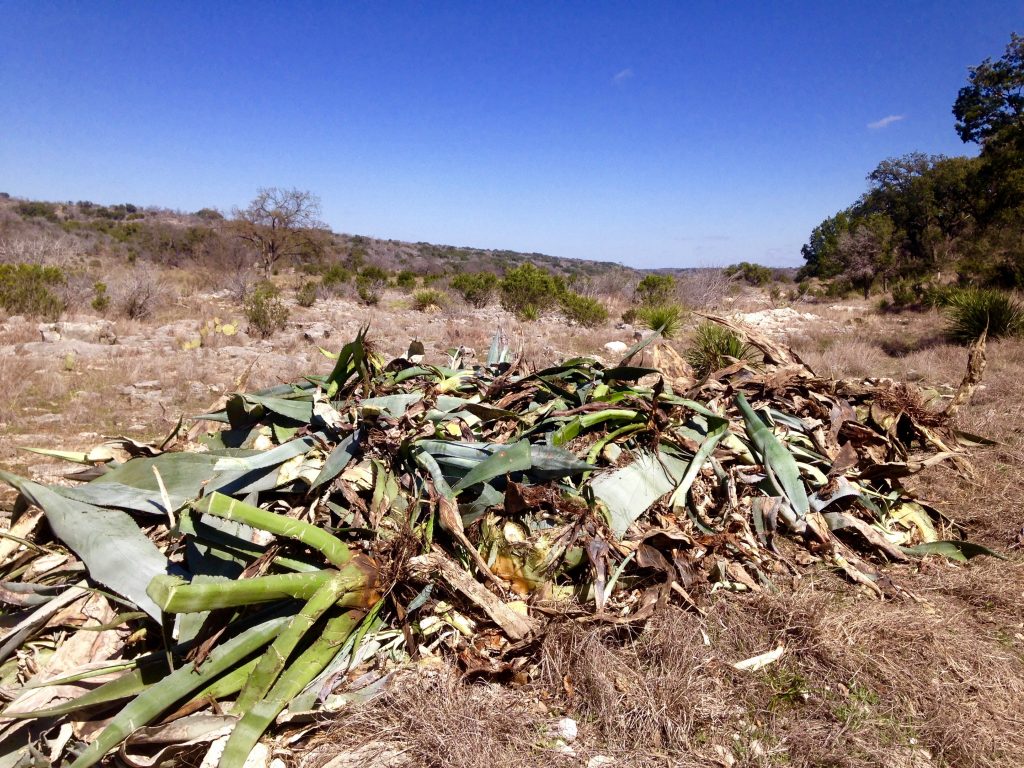
Agave graveyard: Discarded Agaves lay on the rocky watershed where they can’t make contact with soil and resprout. Photo by Monika Maeckle
gas and the agave released its grip on the rocks and earth holding it in place. We dragged the plant to the “agave graveyard’ on the karst watershed where it could not make contact with soil. Like its thorny sibling prickly pear, agave is famous for resprouting if any of its greenery touches the earth. Experts caution not to add it to the compost pile, either. It will quickly take root.
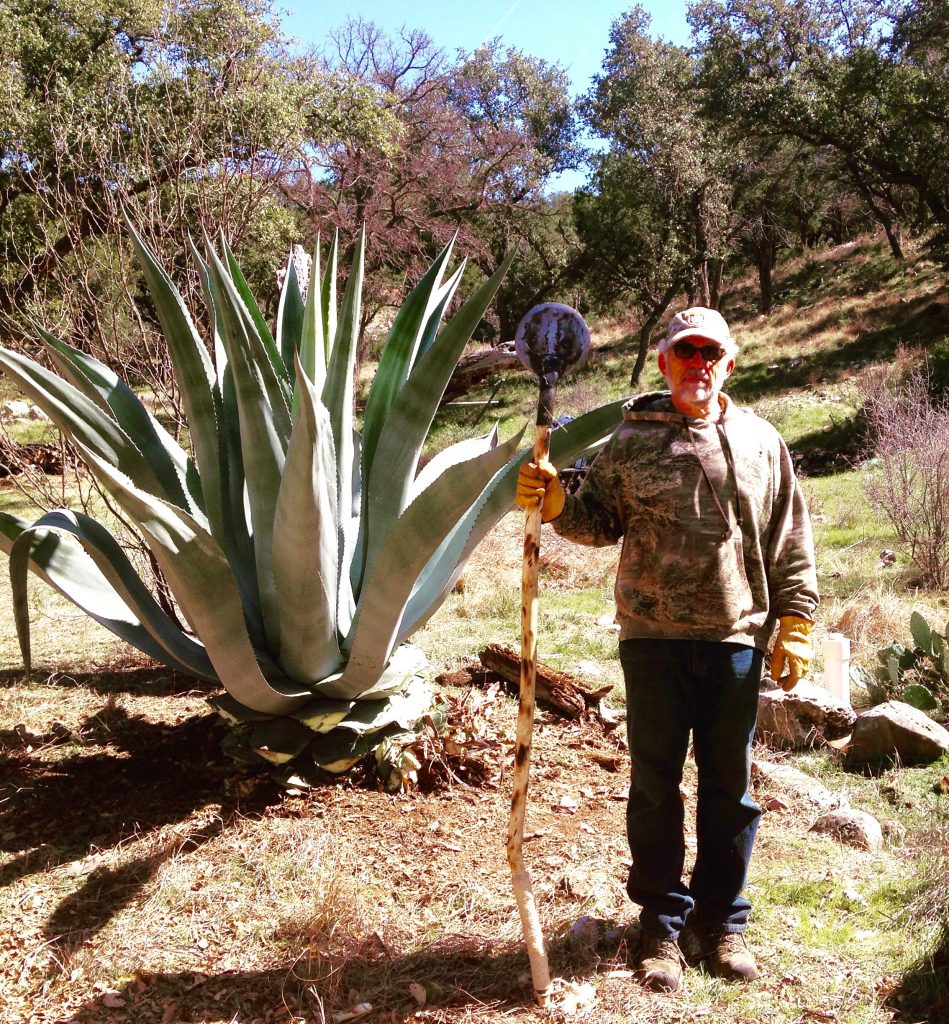
My husband Robert Rivard with his Coba, a tool provided from a horticulturist friend in Mexico to keep the agaves under control. Photo by Monika Maeckle
As a gesture of my respect for this plant, we’ve allowed two specimens to remain on site. We await their century plant spurt, the year when these mighty agaves will shoot their reproductive stalks skyward and grace us with pollen powdered yellow flowers that will attract bats and hummingbirds. In the meantime, we manage the plant aggressively, snipping its hefty mature leaves with the coba, and clearing the pups regularly.
Once these agaves springs their seeds, we’ll shut down agave production on the ranch.
Related posts:
- Trinity Students continue battle with Johnson Grass
- New study: nectar plants more important than milkweed for Monarch butterfly migration
- How to plan a successful pollinator garden
- Mostly native urban butterfly garden outperforms lawn every time
- IH-35 to Become Pollinator Corridor for Bees, Butterflies and other Pollinators
- Endangered Species Act: Wrong tool for the Job of Monarch butterfly Conservation?
- Texas Butterfly Ranch Native Texas Milkweed Guide
- A Year in the Life of a Mostly Native Urban Butterfly Garden
Like what you’re reading? Follow butterfly and native plant news at the Texas Butterfly Ranch. Sign up for email delivery, like us on Facebook, or follow us on Twitter, @monikam.

You are making me thirsty! Why not distill it? According to this link that species is used by some small producers in Oaxaca. http://mezcalphd.com/2013/03/how-many-varieties-of-agave-can-be-used-to-make-mezcal-take-2/
Are you for real? I’m all over trying to help with the Monarch’s captivating mine and the youngsters attentions.
I’ve been promoting among my neighbors and every home owner that I’ve been sent to working at to keep the Monarchs survival.
What about those who depend upon the harvesting of the Agave to make their livelihood?
How about more on hand what can we do with, in my case, > than two dozen caterpillars with freezing temps for the next week!
Because these Agave americana ARE native, they DO have a place here in the US. They ARE NOT invasive. Butterflies, hummingbirds, and bats use them regularly when flowering, and will come from miles away to visit these A. americana flowers, which happens for the plant once in a lifetime. If you decide you didn’t plant them in the right place and want them out, remove all the pups on a regular basis, this will “force” the mother plant to bloom (over time). The actual blooming process takes the better part of a year, and as the flowers develop, the mother plant starts to decline, taking about another year. Because you trimmed off the pups, the plant will die. Be aware that many animals will dig into and under the root system, where the soil is relatively loose, and stay there during the day, shaded and relatively cool. Gopher tortoises, and as many as hundreds of other animals will share the burrow.
This plant should be planted where they will not be interfered with. The spines are stout, sharp and will easily puncture every part of most animal bodies. They are a natural barrier (much like the Osage Orange trees, Locust trees, roses, and other thorny plants once were), so fences may not be needed to keep animals, including people, out. They are good visual barriers, and should be planted with some thought to the future.
I agree, they have a place. We inherited a few large ones along our back fenceline when we bought our house in 2005. Of course my husband wanted me to get rid of all of them because of their thorns. I did cut the thorns off on the yard side but not to the back. Now, in 2024, there are none left. They met their demise in the deep freezes we have experienced in recent years. I actually love this Native Texas plant. It is so attractive and carefree but not for everybody. Now, I have several small plants in pots. I think they are great specimen plants and keep them in a pot. Very pretty and hardy.
That reminds me of my war with the dandelions that are trying to take over my frogfruit. (smaller scale & not quite so hard on the body). There is an old home in far north Denton that has a dense row of these all along their long curb on a curved street. They have been there for decades.
My grandfather made Dandelion wine….
Fascinating reading. Important message here, if it’s not native plant with care!! Same for introduced animals. We have a problem with wild pines and opossums.
So glad to read this article recounting your battle with these plants. My in-laws planted three on my backyard slope now it’s full of them. I’ve been digging up the babies and throwing them out. There are so many. I didn’t even know what type of plant it was until doing a google search.
I love them in pots as beautiful specimen plants. They will freeze on occasion, even in the ground. I agree that they do require “birth control”! They do have a lot of pups but so many other great attributes. They use little water, look amazing, do not require clipping, etc. I use a long, serrated knife to trim mine up when needed, cutting as close to the main body of the plant as possible. On the side along the front, where my husband or grandchildren may get poked, I cut the thorns off with scissors that are on the ends.
Thank you for this advice – similar tale at our place. Weekender that at best is every other week, more often every other month. It’s rural NSW, Australia, and the neglected agave when we arrived is now a multi-generational swathe after several years. Definitely not native, so time for some guilt-free drastic culling. Wish I could find a cabo here.
Is it safe to burn the dried leaves? My huge agave bloomed about a year ago. I let the bees and hummingbirds feast. When the 35 ft stock was dry enough to cut, I had it removed. The plant remained and dried up enough to roll it to an open area. The leaves are dried now and come off easily. I put some in my fire pit but wonder if the smoke is toxic?
I made mistake of planting too many Agave Americana in my backyard five years ago. Have been struggling to keep pace with the pup removal, which is hard work. Finally I had to pay for gardener to remove some of the large mother plants. But I saw that he didn’t manage to remove the whole root underneath. Can anyone tell me if the root left below the soil surface will start to grow again? I pray not!